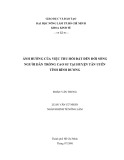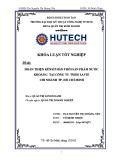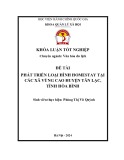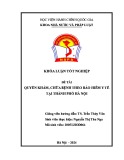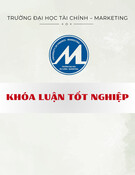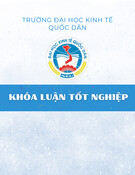
MINISTRY OF EDUCATION
AND TRAINING
MINISTRY OF
HEALTH
INSTITUTE OF NUTRITION
------------------
TRAN VIET NGA
THE EFFECTS OF CONSUMING FORTIFIED
RICE WITH IRON AND ZINC ON THE
NUTRITIONAL STATUS OF WOMEN AT THE
AGE OF 20 TO 49 IN RURAL AREA, THAI BINH
PROVINCE
Major: Nutrition
Code: 9720401
THE ABSTRACT OF THESIS
HA NOI – 2022

THIS STUDY HAS BEEN COMPLETED IN
THE NATIONAL INSTITUTE OF NUTRITION
Academic advisors:
1. Prof. Dr. Le Danh Tuyen
2. Assoc.Prof.Dr. Pham Van Thuy
Reviewer 1:
Reviewer 2:
Reviewer 3:
The dissertation is defended before the Dissertation Assessment
Council - institutional level at the National Institute of Nutrition.
Time: ....... date .......month .........year 2022.
The dissertation can be found at:
- The National Library
- The library of the National Institute of Nutrition

LIST OF PUBLISHED STUDIES OF THE AUTHOR
RELATED TO THE DISSERTATION
1. Tran Viet Nga, Le Danh Tuyen, Pham Van Thuy, Tran Thuy Nga,
Ninh Thi Nhung. Chronic energy malnutrition and several related
factors of women at childbearing age, Vu Thu district, Thai Binh
Province in 2015. Nutrition and Food Jounal, number 6 volum 17,
2021.
2. Tran Viet Nga, Le Danh Tuyen, Pham Van Thuy, Tran Thuy Nga,
Ninh Thi Nhung. The effects of fortified rice with iron and zinc on
anthropometrical status of women at childbearing age in Vu Thu
district, Thai Binh province 2016. Journal of Preventive Medicine,
volume 31, number 9, 2021, page 152-159.

1
FOREWORDS
Chronic energy deficiency (CED), micronutrient deficiency, especially iron and zinc still remain
public health issues in a number of developing countries, including Viet Nam.
CED, micronutrient deficiency affect to the development of physical, cognitive as well as increase the
morbidity and mortality in women at childbearing age. In Viet Nam, the prevalence of Chronic energy
deficiency among women at childbearing age was 18.5% in 2010, of anemia was 29.2% nationwide, among
that the one of anemia in the Red River area was 23.5%. According to the Nutrion Survey in 2014-2015, the
prevalence of zinc defficiency still remains high.
Food fortification is one of the measures with slow but wide and enduring effects. In 2009, WHO
published different measures and provided evidences for the effective interventions to prevent or mitigate the
deficiency of vitamins and minerals. Therein, fortified rice with iron and other micronutrients is one of the
intervention measures for public health.
Study on the effects of fortified rice with iron and zinc by mixing premix and conventional rice for
daily consumption by women in rural area is a scientific envidence to reduce the chronic energy
malnutrition, anemia, micronutritient deficiency in women at childbearing age with the objectives as below:
1. Evaluate the prevalence of chronic energy deficiency, anemia, iron deficiency, zinc deficiency and
related factors in women at the age of 20 to 49 at Minh Khai commune and Nguyen Xa commune of Vu Thu
district, Thai Binh province.
2. Evaluate the effects of the consumption of fortified rice with iron and zinc after 12 months of
intervention on anthropometrical status of women at the age of 20 to 49.
3. Evaluate the effects of the consumption of fortified rice with iron and zinc after 12 months of
intervention on nutrition status of women at the age of 20 to 49.
Contribution of the study:
With the results of significant improvements of anthropometrical, micronutrient status, the study
contribute to making plan of intervention to improve the nutritional, anemia, micronutrient deficiency for
women at childbearing age living in high risk areas. The outputs of the study are helpful for us to make
recommendations for the draft of National Nutrition Strategy in the period of 2021-2030 and are scientific
foundation for the Government to decide the compulsory regulation of iron and zinc fortification into rice –
supplemented for current effective interventions: fortification of iron and zinc into wheat – one of the less
common food in Viet Nam especially in rural and low income areas.
Content:
The dissertation includes 128 pages as follow: Forewords and Objectives of the study: 3 pages;
Overview: 36 pages; Subjects and Research methods: 22 pages; Results: 35 pages; Discussion: 29 pages;
Conclusions and Recommendations: 3 pages. The dissertation contains 37 tables, 7 figures and 186
references.

2
Chapter I. OVERVIEW
1.1. Chronic energy deficiency in women at childbearing age
Chronic energy deficiency (CED) is a status affected by many factors. The main factor is the energy
deficiency of intake. Lack of household food security, low awareness, lack of safe water, environment
sanitation and low healthcare services are potential causes of CED.
CED causes different adverse in women at childbearing age such as: increase the susceptibility to
infections, weakens the immune system, and slow recovery. Mother with CED can increase mortality and affect to
nutrition status of the baby. In addition, CED can cause the bad effects to the economic status of households and
nation economy because it reduces labor productivity, causing bad effects to many generations.
1.2. Micronutrient and micronutrient deficiency
Micronutrient deficiency in women at childbearing age is a public health issue in developing
countries including Viet Nam, especilly women in rural area with low intake in term of quality and quantity.
There have been good results in improvement of nutrion status and prevention of micronutrient deficiency
for women but high prevalences of CED and micronutrient defficiency remain important issues of public
health in our country.
1.3. Fortification of iron and zinc into rice to prevent micronutrient deficiency.
According to the definition of WHO/FAO: Food fortification is to fortify micronutrients into food to
improve the nutritional quality of food, improve public health together with minimize the bad effects to
community. Currently, food fortification has been implemented in many countries since the beginning of the
20th Century. It is one of the most effective interventions worldwide and also a measure recomended by
WHO, WFP, UNICEF, FAO và WB to solve the situation of micronutrient deficiency.
Rice is one of the main food of asian people, including Vietnamese. According to the Survey of the
National Institute of Nutrition in 2010, rice was a main energy intake (66,4%); protein intake 41,4% and
lipid intake 14.9%. Therefore, rice is selected for fortification because of its quality and selection of
consumers. There have been different studies on comunity’s acceptablity of fortified rice.
1.4. Some studies on the effects of food fortification in women
Intervention studies shown that, consumption fortified food (iron, zinc) can improve the anemia,
iron, zinc deficiency in 2 high-risk groups: children and women at childbearing age. With the advantages of
reasonable price, not changing the habit of using food, easy to apply in a big community, food fortification is
considered as middle-term solution for the strategy of prevention for micronutrient deficiency and had been
applied in many countries.
CHAPTER 2. SUBJECTS AND METHODS
2.1. Subjects, place and time of study
Subjects for evaluation of CED and anemia: women at the age of 20 to 49 and voluntarily
participated in this study. Exclusion criteria: women with pregnancy, lactating less than 12 months, disorder
or unable to interview.
Subjects for intervention: women with BMI >16,0 (kg/cm2) and < 25 (kg/cm2), living in studied
communes at least 12 months, volunteer for participation and follow all the study activities.
- Place for study: The cross-sectional descriptive study in Minh Khai commune and Nguyen Xa
commune, Vu Thu district, Thai Binh province. The community intervention study: Minh Khai is
intervention commune and Nguyen Xa is control commune.






